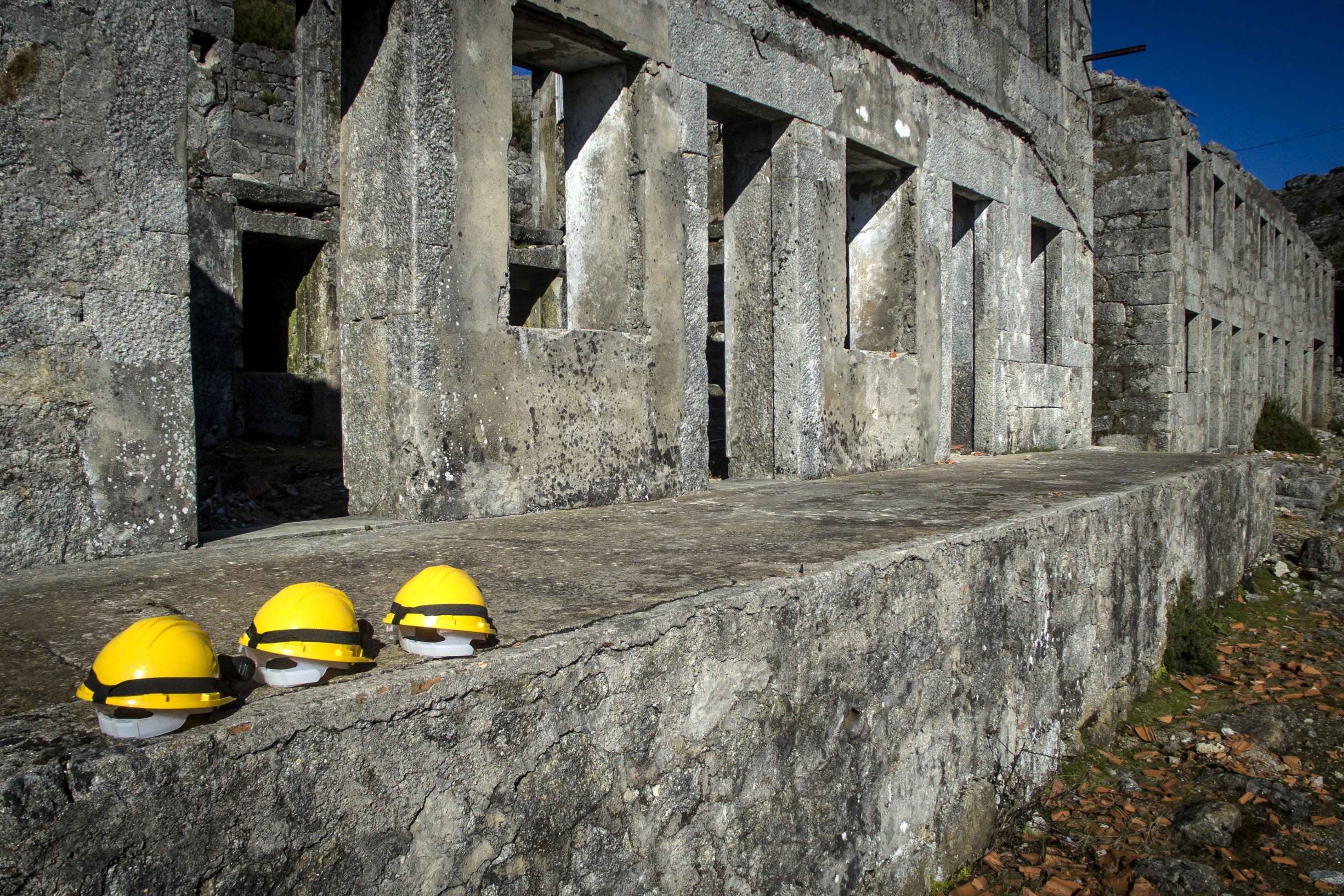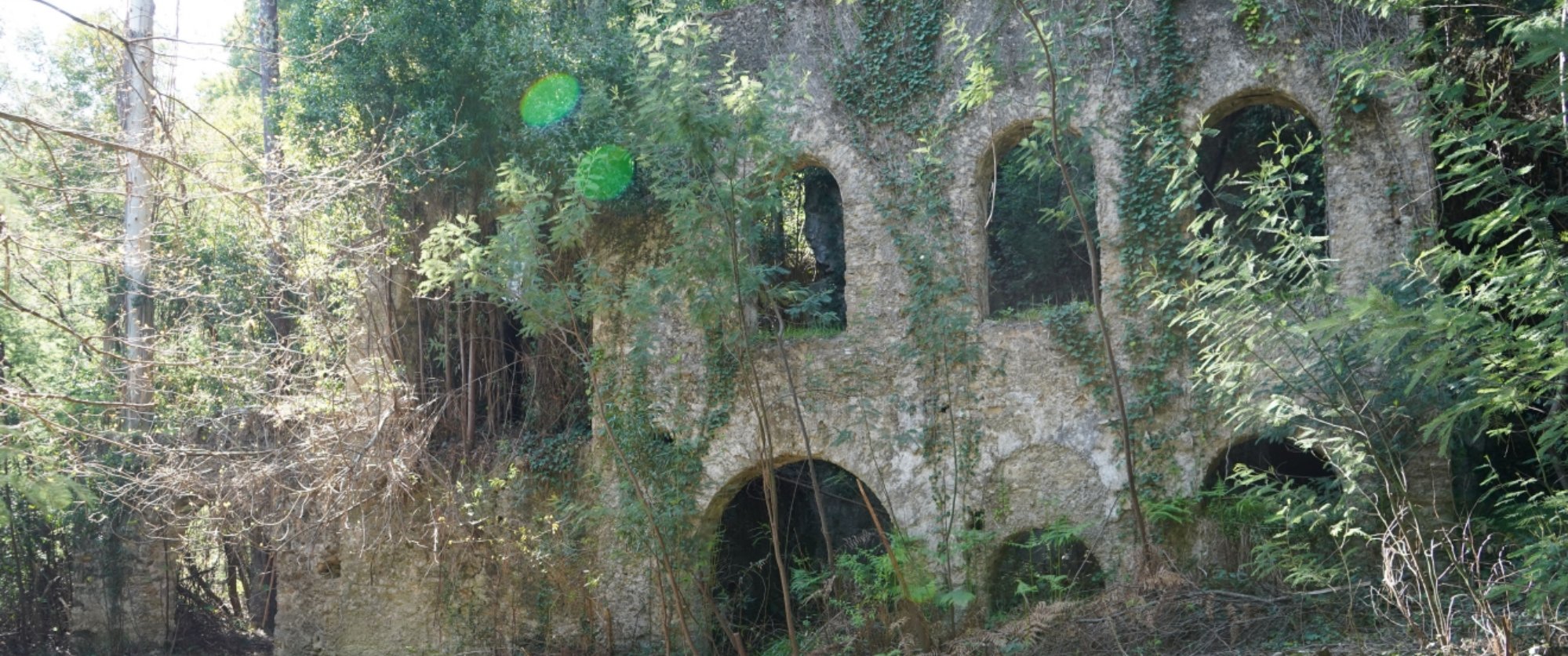Complexo mineiro da Poça da Cadela, Regoufe (Geosite), Arouca
Since the beginning of the 20th century the "Mine Manifests" have declared numerous areas of metalliferrous interest in the parish of Regoufe. On January 9, 1915 the permit was issued for the exploitation of the "Regoufe Mine," or Poça da Cadela, under the jurisdiction of the Frenchman Gustave Thomas. However the height of exploitation occurred after 1941, the year in which the Portuguese Mining Company was constituted, which operated essentially under British management and capital. It became known as the "English Company" and was responsible for important improvements in the region, such as the opening of the roadway from the Telhe Bridge, installation of electricity and telephone systems in the mines (Vilar 1998). The Poça da Cadela mining complex comprised an area of 57 ha for the mining exploitation of W and Sn, and included technical and administrative facilities as well as residences and diverse entries to the galleries. It was the most profitable concession in Regoufe, and today it is still possible to find diverse galleries and excavation heaps spread throughout the entire central zone. The change caused to the landscape by the ruins, galleries and excavation heaps provides the geosite with an elevated level of interest from a cultural and mining archaeological viewpoint. Bibliography: Vilar, A. (1998). O volfrâmio de Arouca no contexto da segunda guerra mundial (1939 – 1945). Câmara Municipal de Arouca (Ed.), 61 p.
CHARACTERISTICS
City: Arouca
Postal Code: 4540 - 000
Telephone: 256940254
Email: geral@aroucageopark.pt
Website: http://www.aroucageopark.pt
Specific Conditions:
Visitas turísticas: marcação através de www.aroucageopark.pt
Method:
Private vehicle
Difficulty Level:
Average
Group Visits:
Yes
Minimum Number of Person per group:
8
Maximum Number of Person per group:
30
Observations:
-
Guided Tours:
Yes
Observations:
Reservations 8 days in advance
Field Trip 7 - "Stories of Tungsten" This educational program takes you to visit around the Mining Complex of "Poça da Cadela", where you can visit some underground mining and get a glimpse of the importance of mining activity in the area.
Target Audience:
Students from Secondary to University
Activity Cost:
3€
Weekly Schedule:
monday, tuesday, wednesday, thursday, friday
From 09:00:00 to 12:30:00.
From 14:00:00 to 17:30:00.
Weekend and Holidays Schedule:
saturday, sunday, holidays
From 09:00:00 to 12:30:00.
From 14:00:00 to 17:30:00.
Exceptions:
-
Observations:
Buses with 25 seats is required for this visit.
http://www.min-saude.pt/Portal/servicos/prestadoresV2/?providerid=344
Where to Stay
http://www.geoparquearouca.com/?p=turismo&sp=turismoemp
Where to Stay
http://www.geoparquearouca.com/?p=turismo&sp=turismoalojamento
Where to Eat
http://www.geoparquearouca.com/?p=turismo&sp=turismorestauracao
Cultural Facilities
Culturais http://aroucageopark.pt/pt/planear/contactos-uteis/loja-interativa-de-turismo/
Táxi
Agency Name:
Praça de táxis de Arouca
Telephone Number:
256944424
Parking for private vehicles:
Yes
Starting from the village of Regoufe, the traditional trails and mountain trails of the foot trail PR 14 "The Magic Village" take us to the ghost town of Drave. Isolated in a valley between the Serra da Freita and Arada, this schist town is an inviting location from which to enjoy the tranquillity of the landscape and the refreshing waters of the Palhais Stream. http://www.geoparquearouca.com/?p=turismo
gps: 40.86105 -8.11731
distance: 4km
The Paivo Trail
By traditional paths of slabs, deeply marked by the passage of countless ox carts, the foot trail PR13 "Na Senda do Paivo [The Paivô Trail]" takes us to Regoufe and to Covelo de Paivo. The geotourist trail is crossed by water lines from the Regoufe stream and the Paivô River, which have formed extraordinarily beautiful valleys. http://www.geoparquearouca.com/?p=turismo
gps: 40.88347 -8.16512
distance: 0km
Geoparks in Portugal UNESCO World Geoparks are territories with locations and landscapes of international geological importance, which combine the protection and promotion of its heritage with sustainable development. They are unique places where the oldest memories are millions of years old and include key locations that testify to the evolution of our planet. These territories are classified by UNESCO under the International Geosciences and Geoparks Program. Spread across all continents, geoparks are much more than areas of heritage relevance. They are dynamic territories of which local communities are part, where nature, history and culture are intertwined. There are currently 5 UNESCO World Geoparks in Portugal: Naturtejo (2006), Arouca (2009), Azores (2012), Terras de Cavaleiros (2014) and Estrela (2020). The Geopark on the coast of Viana do Castelo is preparing the future application, but its level of implementation in the territory, namely the educational offer it already develops, led to its inclusion in the GUIDE OF THE PORTUGUESE GEOLOGICAL AND MINES SITES, naturally without the status that UNESCO gives to the remaining territories. On the other hand, new applications are being developed, with several projects in the Oeste, Algarve and Figueira da Foz, which in due time may have their presence on this platform. To visit Portuguese geoparks is to embark on a journey that began 600 million years ago, when Portugal occupied a very different place on the globe, going through incredible episodes of formation and destruction of mountains and seas, of the appearance and extinction of species, of the occurrence of deep climate change, major volcanic eruptions ... until today in the relationship between man and the planet On this GUIDE the visitor will find a proposed itinerary to visit the most significant points in each national geopark, including, of course, the one located in the Autonomous Region of the Azores. Take a "good trip" on the GUIDE OF THE PORTUGUESE GEOLOGICAL AND MINES SITES and discover the interesting places we introduce you throughout the country.
Wolfram Route
The history of the twentieth century is deeply marked by the arms race and the two World Wars that ravaged the European continent. During this period, the race for wolfram assumes high importance and remains large-scale until the late 1950s. Portugal emerges as the largest European producer of this mineral, benefiting from the richness of its geological resources, multiplying a little throughout the country the mining explorations that profoundly mark the evolution of the local landscape and economy. With the reduction in demand for this mineral from the middle of the century and the emergence of new producing markets, interest in wolfram in Portugal has declined, leading to the abandonment of explorations. The structures of this golden period of mining in Portugal remain in the landscape, still marking the regions that surround them.
The Braçal mining complex includes the Braçal, Malhada and Coval da Mó mines and extends along the Mau River, on the eastern slope of the Serra do Braçal. This complex is the oldest Portuguese mining concession, registered under number 1, a ...
It tells the story of a territory, disclosing its heritage and elements of cultural and ethnographic interest. It is also a place where one investigates, protects and learns about Sever do Vouga's heritage. It approaches Archeology in Terra ...
The Museum was designed with two floors with a total area of 1240 square meters. The building has a lower floor, which includes the permanent exhibition dedicated to quartz, with a strong interactive component where the mineral is explored ...
The Stone Museum of Marco de Canaveses is more than what you see. The permanent exhibition is the first step of a project to extend the Museum to other places. In the future it will be a polynuclear museum. Larger, dynamic and innovative. ...










